Exploring Masdar City: A Model for Sustainable Living

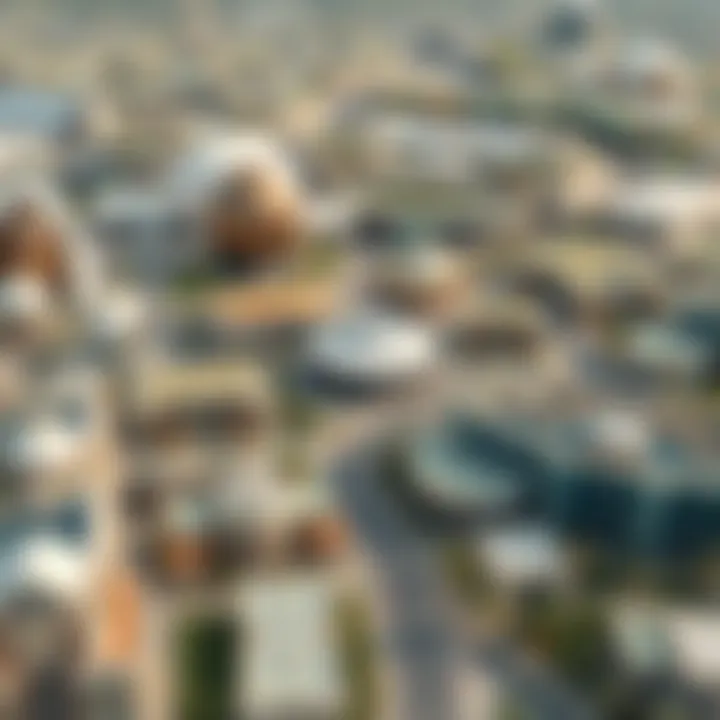
Intro
Masdar City, situated in the heart of Abu Dhabi, is no ordinary city. It stands tall as a beacon of what the future of urban living could look like. This innovative initiative embodies a commitment to sustainability and eco-consciousness, striving to create an environment that harmonizes with nature rather than against it. By harnessing renewable energy sources and implementing cutting-edge urban design principles, Masdar City aims to set the stage for how communities might evolve as we face the growing challenges of climate change and urbanization.
In this exploration, we will delve into several crucial aspects of Masdar City. From its architectural framework to the economic implications of this venture, each facet offers a glimpse into its role as a potential blueprint for future cities across the globe. We will also examine the current market dynamics and investment opportunities tied to such a pioneering project. Understanding Masdar City is essential, particularly for investors, developers, and urban planners looking to navigate the future of urban development.
There is much to learn, so let’s embark on this journey through the intricacies of one of the world’s most fascinating urban explorations.
Overview of Masdar City
Masdar City stands as a hallmark of modern urban development, a testament to what can be achieved when innovation meets sustainability. As cities across the globe grapple with issues related to climate change, overpopulation, and dwindling natural resources, Masdar City emerges as a beacon of hope. This section seeks to illuminate the importance of Masdar City in the broader context of urban living—its unique features, the benefits it offers, and the pressing considerations surrounding its development.
Definition and Purpose
Masdar City is primarily conceived as a zero-carbon city that aspires to integrate cutting-edge technologies with sustainable practices. The very essence of this ambitious urban project is to create a community where the ecological footprint is minimized, and renewable resources take center stage. In a world where traditional urban planning often neglects environmental impact, Masdar City flips the narrative, advocating for a lifestyle that is in harmony with nature.
The purpose of Masdar City extends beyond its geographical boundaries; it aims to serve as a model for future urban developments, demonstrating that ecological and economic objectives can indeed go hand in hand. This forward-thinking project anticipates the needs of the future and tries to address them head-on, showing that a sustainable approach is not only possible but also essential for long-term prosperity.
Geographical Location and Significance
Situated in the heart of Abu Dhabi, Masdar City is strategically placed within a region that is rapidly evolving in terms of technological advancements and economic opportunity. The choice of location speaks volumes about its significance. Abu Dhabi, being a nexus for energy resources and a focal point for innovations, lends Masdar City a distinct advantage. Its proximity to various cultural, commercial, and technological institutions makes it a prime candidate for attracting investments and talent.
The environmental context is equally notable. Built in an arid climate, Masdar City emphasizes the use of sustainable design principles to tackle serious climate challenges, particularly water scarcity and extreme temperatures. The very layout of the city, featuring shaded pathways and environmentally adaptive buildings, showcases how architecture can directly influence comfort and energy efficiency.
This geographical positioning not just enhances the significance of Masdar City, but also underscores its potential role as a global leader in sustainable urban planning. The relevance of such a development in today’s increasingly environmentally-conscious landscape cannot be overstated. As urban planners, developers, and investors look for models that embody sustainable living, Masdar City offers valuable lessons that resonate worldwide.
"In an era defined by environmental challenges, Masdar City stands as a practical response, coupling visionary design with ethical responsibility."
This overview frames Masdar City as more than just a construction project; it’s a global vision for how urban living can harmonize with the environment. As the article progresses, we’ll explore the historical background, underlying sustainability principles, and the future trajectory of this pioneering urban development.
Historical Background
The historical background of Masdar City reveals much about its vision and goals. Understanding what led to its conception enables us to appreciate the bold decisions made by its founders and the ongoing implications for urban development. Initiated in 2006, Masdar City was designed as a response to the growing concerns about climate change and the need for sustainable urban solutions. By delving into the inception and the key stakeholders, we can see a clearer picture of the importance of this innovative project in shaping urban landscapes.
Inception and Development Timeline
Masdar City was born out of a desire to showcase a greener future, serving as a beacon of sustainability in one of the world's hottest regions. The initial groundwork was laid in 2006, when construction kicked off in Abu Dhabi. Since then, several milestones have marked its evolution:
- In 2007, the Masdar Initiative was formally established, focusing on developing clean technologies.
- By 2010, Masdar City became home to the world's first zero-carbon, zero-waste city. It emphasized renewable energy and sustainable living practices.
- In subsequent years, a renewable energy showcase was constructed, with features like the Masdar Institute of Science and Technology, collaborating with international universities.
- In 2019, significant strides were made, such as integrating smart transportation systems and expanding public engagement through various workshops and events.
These steps were not just phases of construction; they reflected a strategic roadmap to create a global center for innovation.
Key Stakeholders Involved
The development of Masdar City is not solely attributed to a singular vision. Several key stakeholders intertwined their expertise and resources to elevate the project.
Some notable stakeholders include:
- Abu Dhabi Future Energy Company (Masdar): As the primary developer, Masdar plays a pivotal role in guiding the city's growth through sustainable practices.
- International Governments and Organizations: Various global entities provided invaluable input and resources, enhancing Masdar's international standing.
- Private Sector Partners: Companies specializing in renewable energy and design contribute their knowledge, pivoting the project towards innovative technologies.
- Academic Institutions: Collaborations with renowned educational entities, such as the Massachusetts Institute of Technology, have fostered research and development, promoting sustainability principles.
"Vision without action is merely a dream. Action without vision just passes the time. Vision with action can change the world."
– Joel A. Barker
Understanding the network of stakeholders demonstrates the collective effort behind Masdar City. It's a melting pot of ideas and visions aimed at crafting an environment where sustainable urban living can flourish. This section lays the groundwork for realizing the potential benefits and the multifaceted approach that may inspire other regions to adopt similar frameworks.
Key Principles of Sustainability
Understanding the key principles of sustainability in Masdar City is akin to peeling back layers of an onion; each layer reveals depth and thoughtfulness put into the design. These principles not only underscore the importance of environmental responsibility but also showcase how urban developers can forge a new path. In the context of Masdar, sustainability is not merely about reducing the carbon footprint; it's a holistic approach that entwines renewable energy, efficient resource management, and innovative urban design. This is where both environmental and economic considerations come into play, ultimately aiming for a harmonious balance.
Renewable Energy Utilization
Solar Energy Applications
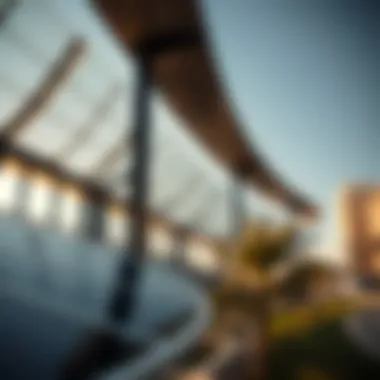
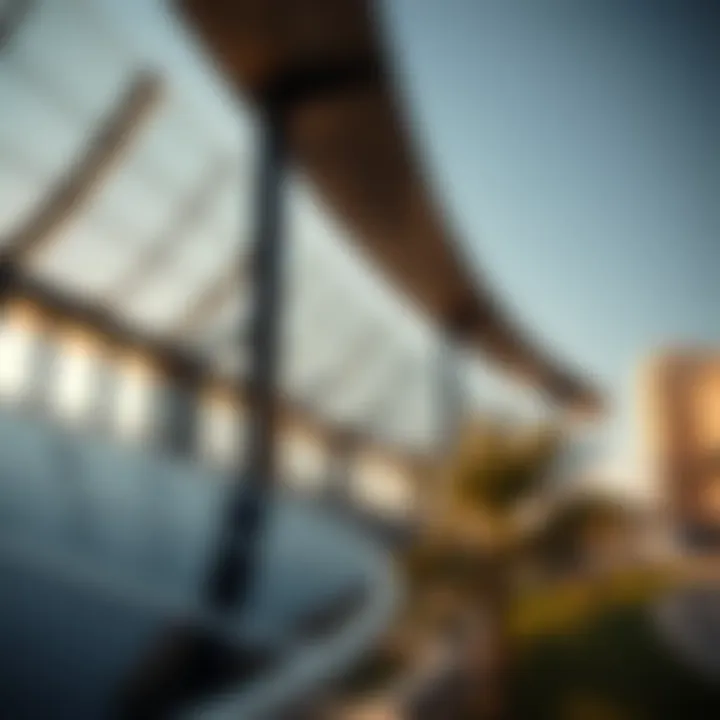
Solar energy is at the core of Masdar's quest for sustainability. The city utilizes vast solar farms equipped with photovoltaic panels. These panels capture sunlight and convert it into electricity, significantly contributing to the energy demand of the city. This approach is a prime example of how local resources can be harnessed for significant impact. A key characteristic of solar applications in Masdar City is their adaptive design; they can also integrate seamlessly with building architecture.
One unique feature of these solar systems is their ability to store energy for later use, cushioning the fluctuations of daylight. This flexibility ensures that Masdar can maintain a stable energy supply even during cloudy days. However, the initial costs of these advanced solar installations can be quite hefty, which might deter some investors. Yet, the long-term savings on energy bills and the appeal of low-carbon living often outweigh the upfront costs.
Wind Energy Integration
Wind energy also plays a vital role in Masdar City’s energy strategy. Vertical-axis wind turbines, designed to maximize efficiency in various wind conditions, harness the breezes that sweep across Abu Dhabi. This unique aspect of wind energy integration helps diversify the city's energy profile, reducing reliance on a single energy source.
What stands out about the wind energy initiative is its environmental harmony; these turbines are designed with aesthetics in mind, fitting beautifully into the city’s modern ethos. Although using wind energy has its challenges -- such as variable wind patterns that can affect energy output -- the benefits of these turbines in contributing a clean energy source can be invaluable for meeting Masdar's ambitious sustainable goals.
Water Conservation Strategies
Recycling and Reuse
Water conservation strategies in Masdar City are indispensable. Highlighting the importance of recycling and reuse, the city employs advanced systems to recycle wastewater. This involves converting sewage into reusable water for irrigation and landscaping.
The recycling systems are efficient, reducing the overall water demand significantly, which is essential in a desert climate like Abu Dhabi’s. A unique feature worth mentioning is the use of treated water for cooling systems in buildings, further enhancing efficiency. On the other hand, the technology required for such systems can be complex and costly to implement entirely, posing challenges for some stakeholders.
Efficient Irrigation Techniques
Efficient irrigation techniques are another cornerstone of Masdar’s water conservation efforts. The city utilizes drip irrigation systems that deliver water directly to plant roots, minimizing evaporation and runoff. This method is not only effective but also economical; it ensures that every drop counts.
One distinctive aspect is the integration of native plant species in landscaping, which require less water while sustaining local biodiversity. While this approach is beneficial in conserving water, it could face criticism for potentially limiting the aesthetic choices of residents and developers alike. However, the emphasis on sustainable landscaping aligns perfectly with Masdar’s overarching vision.
Architectural and Urban Design
The architectural and urban design of Masdar City is a linchpin in its aspiration to become a beacon of sustainability and innovation in urban planning. By thoughtfully blending natural elements, cutting-edge technology, and human-centric design, Masdar City does not merely aim to house people; it seeks to enhance their quality of life while minimizing environmental impact. Such urban design is important not just for aesthetic appeal, but for practical, eco-friendly functionality too.
Innovative Design Principles
Masdar City’s architectural approach is rooted in principles that prioritize sustainability and energy efficiency. These principles can be broken down into several key elements:
- Passive Solar Building Design: Structures in Masdar City are designed to maximize natural light while minimizing heat gain. By orienting buildings strategically and using materials with high thermal mass, they are less reliant on artificial heating and cooling.
- Integration with Nature: The landscape architects have embraced the natural desert environment, incorporating green spaces and shade-producing structures to enhance outdoor comfort. This not only fosters engagement with nature but promotes biodiversity.
- Smart Technology Utilization: Advanced building management systems are employed to monitor energy usage and optimize efficiency. This technology enables real-time management of resources, significantly reducing waste.
The beauty of these principles lies in their collective aim to create a livable environment that’s not just functional but also inspiring. The use of local materials, for instance, connects the urban landscape with its cultural context. This thoughtful amalgamation of technology and tradition can serve as a learning model for future urban developments.
Mixed-Use Developments
The concept of mixed-use developments in Masdar City is not merely a trend; it embodies a strategic necessity aimed at fostering a vibrant and connected community. Such developments weave together residential, commercial, and recreational spaces in a seamlessly interconnected manner.
The advantages of mixed-use development in Masdar City include:
- Enhanced Community Engagement: By having shops, offices, and homes within walking distance, residents are encouraged to engage with one another, fostering a sense of community. This integration helps eliminate the isolation often felt in traditional suburban designs.
- Reduced Transportation Needs: With various services and amenities easily accessible, the reliance on cars decreases significantly. This not only eases congestion but also aligns with Masdar's goal of minimizing its carbon footprint.
- Economic Resilience: Mixed-use areas can help boost local economies by attracting businesses and creating a diverse job market. This economic dynamism is vital as it ensures the city can adapt to changing conditions.
Through these mixed-use developments, Masdar City showcases how thoughtful design can play a pivotal role in achieving sustainable urban living.
“Sustainable urban development is about more than just green technologies; it’s about creating places where residents can thrive, in every sense.”
Each design choice made in Masdar City speaks to broader aspirations, reflecting a vision where urban spaces harmonize with environmental stewardship and the dynamism of community life.
For further reading on urban design practices, consider visiting Wikipedia or Britannica.
Transportation Systems
Transportation systems are the backbone of urban development. In Masdar City, they are tailored not only to enhance connectivity but also to underscore the city’s commitment to sustainability. These systems employ cutting-edge technology designed to reduce the carbon footprint while delivering efficiency for residents and visitors alike.
Electric and Autonomous Vehicles
Electric vehicles (EVs) and autonomous pods play a pivotal role in the transportation strategy of Masdar City. By integrating these eco-friendly options, the city aims to minimize emissions and create a cleaner environment. The fleet of electric vehicles is designed for zero emissions, consequently promoting air quality improvement. These cars are powered by renewable energy sourced from the city’s solar farms, aligning with its sustainability goals.
Moreover, autonomous vehicles serve as a futuristic solution to urban transit. Not only do they provide convenience, but they also aim to reduce traffic congestion. By utilizing sophisticated algorithms for navigation, these vehicles can optimize routes and schedules, ensuring that residents get to their destinations swiftly.
Interestingly, Masdar City also explores the integration of shared mobility solutions. Car-sharing services that utilize electric vehicles provide additional flexibility for residents, allowing them to access transport without the need for owning a private vehicle. The result is a reduction in the number of cars on the road, leading to a less congested urban landscape.
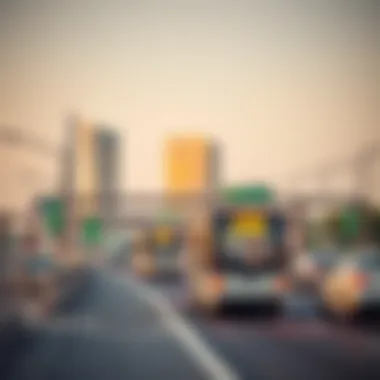

Public Transport Initiatives
Public transport initiatives in Masdar City are thoughtfully conceived to connect various parts of the city while promoting sustainable transportation modes. The city has strategically planned its layout to ensure that public transport is accessible, running seamlessly alongside pedestrian pathways and cycle tracks.
Key Elements of Public Transport in Masdar City:
- Light Rail: A proposed light rail system is designed to link Masdar City to nearby urban centers, enhancing connectivity while minimizing the reliance on personal vehicles.
- Buses: Electric buses are another fundamental aspect, offering an efficient means of getting around the city. These buses can be equipped with real-time tracking systems, allowing users to plan their journeys effectively.
- Cycle Paths: Dedicated bicycle lanes promote cycling as a viable option for short-distance travel, encouraging a healthier lifestyle for residents.
In summary, transportation systems in Masdar City reflect an innovative, forward-thinking approach. By prioritizing electric and autonomous vehicles as well as public transportation initiatives, the city aims not just for functional transit solutions but also for an overall healthier urban environment. This approach sets the stage for a new era of urban development—one that is both efficient and sustainable.
Economic Impact
Exploring the economic impact of Masdar City is crucial for understanding its role in shaping sustainable urban environments. This urban project is more than just a reflection of architectural ingenuity; it serves as a potent catalyst for economic growth and innovation in Abu Dhabi and beyond. The integration of renewables and smart technologies can produce a ripple effect that influences the local, regional, and even global economies.
The financial implications are significant as the city presents a unique blend of investment opportunities, job creation, and enhancement of the local economy. This section delineates how Masdar City stands at the intersection of eco-conscious innovation and economic vitality, showcasing its multifaceted benefits.
Investment Opportunities
Masdar City invites a spectrum of investors eager to tap into the burgeoning green economy. With its focus on renewable energy, technology, and sustainability, investors can partake in various sectors, from solar energy production to advanced transportation solutions. Here are some key aspects regarding investment potential:
- Public-Private Partnerships: The collaboration between government entities and private firms enhances credibility and financial backing, thereby fostering an environment ripe for investments.
- Tax Incentives: Investors may benefit from favorable tax conditions designed to encourage sustainable practices and reduce initial investment burdens. This could make Masdar City particularly appealing to those looking to balance profitability with green initiatives.
- Research and Development Hub: The city acts as an incubator for cutting-edge technologies in various sectors like energy efficiency and clean water access. Investors can either participate in existing projects or develop new ideas with government support.
- Real Estate Ventures: Given Masdar City's unique market position, there are opportunities within the realm of sustainable development projects that range from residential units to commercial spaces optimized for energy efficiency.
In the long run, these investment avenues not only boost the city's economy but also serve as a template for other cities looking to modernize while embracing sustainability.
Job Creation and Local Economy
The establishment of Masdar City has far-reaching effects on the job market and the local economic landscape. As the construction and operational phases unfold, thousands of jobs are created, contributing to reducing unemployment rates in the region. Consider the following points:
- Diverse Job Opportunities: From construction workers to eco-engineers and IT experts, the variety of job roles demanded by this innovative city can elevate the skills of the local workforce. This not only enriches individual careers but also promotes specializations that may serve the region’s long-term economic health.
- Support for Local Small Businesses: With an influx of professionals moving to the city, local bars, restaurants, and shops see a boost in patronage. The commercial landscape thrives as residents seek amenities and services close to home.
- Training and Skill Development: Initiatives within Masdar City promote education and skill acquisition tailored to the needs of the green economy. Educational institutions, both established and new, offer programs directly aligned with the sustainable tech sector, preparing the next generation of workers.
- Enhanced Local Infrastructure: As investments pour in, infrastructures such as transportation networks and public utilities undergo modernization, creating a more functional and attractive living environment for residents and businesses alike.
"Investing in sustainable urban centers like Masdar City not only contributes to immediate economic benefits but also plays a crucial role in addressing long-term environmental challenges."
Through these lenses, Masdar City exemplifies how strategic urban planning can align with economic growth, offering valuable lessons for other cities worldwide.
Challenges Faced by Masdar City
Understanding the challenges faced by Masdar City is crucial for grasping the broader implications of sustainable urban development. Despite its well-thought-out design and promising vision, Masdar City encounters several hurdles that could impact its future success. Addressing these challenges is vital, not only for this particular development but also for other future smart cities looking to emulate its model.
Technical and Financial Hurdles
One of the primary obstacles affecting Masdar City is the technical and financial feasibility of many of its ambitious projects. Initially, the city aimed to integrate cutting-edge technologies that would allow it to function almost entirely off renewable energy. Various innovative technologies, from smart grids to advanced waste management systems, require significant capital investment and consistent funding to become operational and maintain their performance.
Moreover, the rapid advancement of technology often leads to further complications. What may seem like the best solution today could become outdated tomorrow, causing financial strains as updates and modifications become necessary. The challenge, then, lies in balancing the initial investments with long-term sustainability.
"While the vision for Masdar City is exemplary, the practical execution must contend with real-world limitations and uncertainties."
Additionally, financial backing is nothing to scoff at. The volatile global economy can affect construction budgets and timelines. Investors and stakeholders are becoming increasingly cautious, making it harder for projects reliant on large-scale investment to move forward as planned. The success of Masdar City attracts attention, but at the same time raises the stakes; any faltering in the economy could delay development or lead to scaled-back ambitions, undermining the original vision.
- Key factors affecting technical and financial hurdles:
- Rapid technological change.
- Need for ongoing investment and funding.
- Global economic fluctuations.
Public Perception and Acceptance
Equally important are the public’s impressions and acceptance of Masdar City. The concept of a fully sustainable city can seem appealing, yet the implementation stages can evoke skepticism. Communities may feel dislocated or alienated if they perceive this urban initiative as imposed rather than cultivated. Understanding public sentiment is vital to fostering a supportive environment that facilitates cooperation between developers and citizens.
One aspect that often generates doubt is the affordability of living in such a high-tech environment. Many may associate sustainability with high costs; hence, it’s crucial to communicate how living in Masdar City won’t break the bank. Clarifying these concerns so that potential residents can see how their participation contributes to broader sustainability goals is key to overcoming skepticism.
Furthermore, engaging local communities in the planning and decision-making processes can yield positive results. It’s essential for decision-makers to listen and adjust their proposals based on community feedback.
- Considerations for addressing public perception:

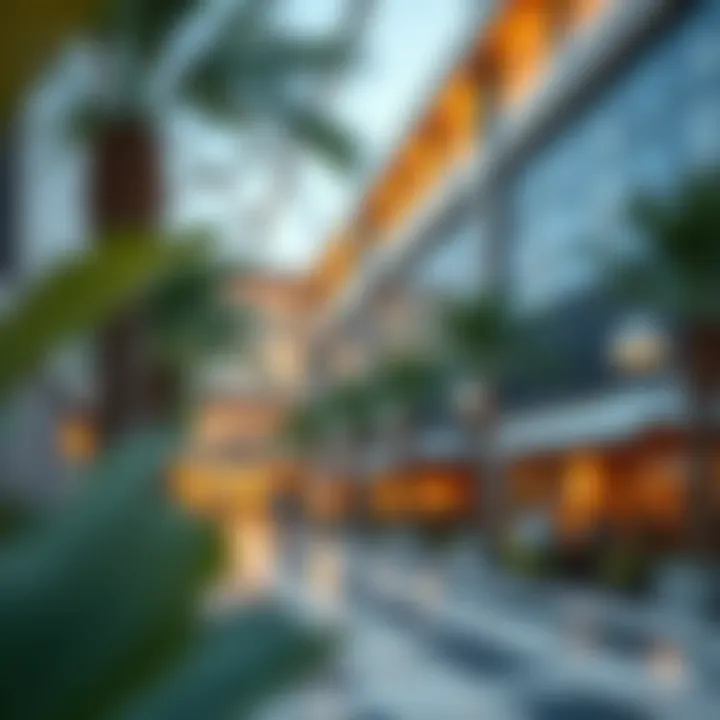
- Transparent communication about costs and benefits.
- Opportunities for public involvement in planning.
- Education on sustainability and technology benefits.
Future Prospects
The prospects for Masdar City reveal a tapestry woven with innovation, sustainability, and ambitious expansion. This section does not merely focus on the expansion but delves into what makes these plans significant for urban development. As cities worldwide grapple with the increasing challenges of climate change, resource scarcity, and urban sprawl, Masdar City stands as a beacon, illustrating the practical implementation of sustainable living.
As Masdar City looks to the future, it must address a multitude of facets: attracting further investments, enhancing its infrastructure, and ultimately scaling its model for broader application. The importance of these prospects spans economic benefits, environmental impact, and social change, all pivotal for redefining urban landscapes.
Expansion Plans
Masdar City is not static; it’s a living project with evolving ambitions. Current expansion plans aim to double the city's size, fostering more residential and commercial properties that align with its sustainability ethos. By introducing mixed-use developments, the city can create spaces where people live, work, and play—all while minimizing their carbon footprint.
Key elements of these expansion plans include:
- Increased renewable energy usage. By incorporating more solar panels and wind turbines, the energy generated in-house could potentially power the majority of new developments.
- More green spaces. Parks and nature preserves are crucial to creating a community that values eco-friendliness.
- Smart technology integration. Internet of Things (IoT) innovations will enable efficient energy management systems and better resource allocation. These plans signify an eagerness to pioneer urban sustainability projects not just within Abu Dhabi, but globally.
Role in Global Sustainability Efforts
Masdar City is not merely a local initiative; it’s a pivotal player on the world stage, influencing sustainable practices for cities everywhere. As it continues to innovate and evolve, Masdar's practices are turning into actionable insights that resonate beyond borders.
The city's commitment to sustainability highlights several vital areas:
- Showcasing renewable practices. Masdar City is a testing ground for state-of-the-art technologies that other cities can adopt. Its use of solar energy and zero waste policies presents replicable frameworks for urban planners.
- Creating educational opportunities. Collaboration with universities and educational institutes adds layers to its initiatives, creating a knowledge hub for sustainability that can inspire next-generation leaders.
- Fostering global partnerships. By attracting international stakeholders who share similar sustainability objectives, Masdar reinforces its position as a model for other cities.
"The future is bright for Masdar City, as it becomes a hub for transformative urban planning and sustainable innovation, and sets a precedent worldwide."
Through these foresightful strategies, Masdar City is not only cultivating its environment but also contributing to an invaluable global discourse on sustainable urban living, making it a relevant focal point for investors, developers, and professionals who seek to make holistic improvements in urban planning.
Masdar City in the Context of Dubai's Real Estate Market
Masdar City is often seen as a fascinating chapter in the ever-evolving narrative of Dubai's real estate landscape. As the UAE's ambitious plans for sustainability come to fruition, this city stands out, not just for its eco-friendly initiatives but also for how it positions itself amidst the luxurious developments that have come to define the Dubai skyline. The significance of Masdar City lies in its ability to provide an alternative vision that complements the more traditional luxury market.
Positioning among Luxury Developments
Located just outside the heart of Abu Dhabi, Masdar City opts for a distinct branding. While many developments in Dubai lean heavily on opulence, Masdar takes a different route by integrating green technologies with modern living spaces. The luxurious aspects here come not from gold-plated fixtures but from the quality of life it offers. This is a city designed with the future in mind, emphasizing sustainability rather than excess.
- Masdar City features cutting-edge architecture that maximizes natural light and reduces energy consumption.
- The city’s massive solar arrays and energy-efficient buildings make it a hallmark of a sustainable lifestyle.
- Unlike typical luxury offerings, Masdar City focuses on community interactions, shared spaces, and eco-conscious choices that encourage a more cohesive living environment.
The allure of Masdar lies in its forward-thinking concepts, making it an attractive choice for individuals and families looking for a lifestyle that marries practicality with environmental responsibility.
Attractiveness for Investors
From the standpoint of real estate investment, Masdar City provides numerous advantages. Investors are always on the hunt for opportunities that promise a good return. Masdar City’s unique proposition as a green urban area appeals to a growing segment of environmentally conscious buyers.
- The demand for sustainable living solutions is on the rise, and Masdar City is perfectly positioned to meet this trend.
- Given that investments in renewable energy and sustainable infrastructure often receive government support, investors might find attractive incentives in this locale.
- The ongoing development projects within Masdar offer varied opportunities tailored to different sectors, including residential, commercial, and industrial real estate.
The developments within Masdar are designed to be self-sustaining. Properties here not only promise capital appreciation but also align with global sustainability goals, enhancing their attractiveness to forward-looking investors.
"Investing in Masdar City is more than just a financial decision; it's embracing a lifestyle choice that reflects the future of urban living."
In essence, Masdar City is carving a niche for itself in Dubai's bustling real estate market, offering an innovative alternative that stands apart from traditional luxury developments. Its commitment to sustainability embodies a shift in consumer preferences, making it an exciting proposition for investors and buyers alike.
Epilogue
In summing up the discussion on Masdar City, we highlight the transformational journey toward sustainable urban living that this innovative development represents. Masdar City acts as a live laboratory, where the principles of cutting-edge technology and holistic environmental practices are put to the test. A spotlight shines on its unique approach to integrating renewable energy solutions, efficient water management, and multi-modal transportation systems that not only aim to reduce the carbon footprint but also enhance the quality of life for its inhabitants.
Summarizing Key Insights
Navigating through the depths of Masdar City has revealed several striking insights:
- Innovative Design: The city stands as a testament to architectural ingenuity, merging modern aesthetics with eco-friendly practices. The layout promotes walkability, with green spaces seamlessly integrated into the urban fabric.
- Global Leadership: Masdar City is positioned as a beacon for other cities grappling with sustainability issues. Its commitment to creating a zero-carbon environment makes it a benchmark for future urban developments worldwide.
- Economic Viability: Investment opportunities created by Masdar City don't just benefit the local economy but can also attract foreign interest. As the world shifts toward greener practices, eco-friendly developments will become increasingly valuable.
- Challenges and Resilience: While the city has encountered its share of hurdles—be it technical or public perception—it continues to adapt and evolve, demonstrating resilience in the face of adversity.
Final Thoughts on Sustainable Urban Living
Considering the trajectory of urbanization and the pressing challenges posed by climate change, Masdar City’s model is not just an experiment—it's a necessary framework for a sustainable future. Urban living is redefined when cities like Masdar prioritize eco-conscious choices. This focus on sustainability cultivates a sense of community and exemplifies how cities can embrace innovation to foster a harmonious balance between development and nature.
In a world where real estate investments align with sustainability goals, Masdar City emerges as a front-runner. Its journey not only underscores the possibilities in urban development but also invites stakeholders across the board—be it investors, developers, or future residents—to be part of this ongoing narrative. For those who wish to explore more about urban sustainable living and opportunities, a wealth of resources are available at Wikipedia, Britannica, and industry-specific forums on Reddit.
As we stand at the crossroads of urban innovation and environmental responsibility, lessons learned from Masdar City will guide us toward building cities that are not just places to live, but also thriving ecosystems supporting a sustainable future.



